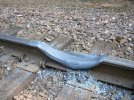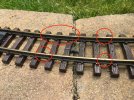You are using an out of date browser. It may not display this or other websites correctly.
You should upgrade or use an alternative browser.
You should upgrade or use an alternative browser.
Tarnished track
- Thread starter Airbuspilot
- Start date
stevedenver
Registered
I have both track loco, and.....lgb blocks.
for filthy track, the block. For sap, etc. add lgb fluid or meths to cut through the goo. But…this can result in a film on the track, a mixture of cleaning fluid and sap, etc. which then must be wiped clean with a cloth.
periodically, i use a toothbrush and detergent to remove brass stuff from the pad.
the block is the most effective.
my cleaning loco takes mutiple passes running slowly to come close.
i caution ..some 3m pads are extremely abrasive and will leave tiny dirt collecting scratches.
btw, the LGB cleaning tires, are seemingly identical 3m abrasive used on the lgb block cleaner....whata coinkydink...these seem to last a really long time, like, i have used mine on about 100 ft of track, 3-5 times weekly, 2-3 passes for about 6 months or more a year, since 1993..no need to do the numbers.....the tires are still fine.
thoughts:
1 if track is wet, and or inclined, the cleaning tires may have more traction /purchase than the loco driving wheels....reverse the cleaning wheel leads so they pull. cleaning is almost comparable. tracking through switches is improved. more crud in the cowl.
2 never put weight on the cowl with the cleaning wheels (to increase downward pressure) , youll wear down the gears in short time.
3 clean the dam loco periodically. keep the cleaning wheel axel (at the point of entry into the forward motor block and cowl and other areas clean and remove the brass oxide dust to avoid abrasion, seizing of the axel. (the plastic cleaning tires, can leave tiny tough nylon-like threads from the flanges that wrap the axel). i will remove the cleaning motor block, and go over the area with detergent yearly, relube, etc. i blow the track dust out each time i finish use.
for filthy track, the block. For sap, etc. add lgb fluid or meths to cut through the goo. But…this can result in a film on the track, a mixture of cleaning fluid and sap, etc. which then must be wiped clean with a cloth.
periodically, i use a toothbrush and detergent to remove brass stuff from the pad.
the block is the most effective.
my cleaning loco takes mutiple passes running slowly to come close.
i caution ..some 3m pads are extremely abrasive and will leave tiny dirt collecting scratches.
btw, the LGB cleaning tires, are seemingly identical 3m abrasive used on the lgb block cleaner....whata coinkydink...these seem to last a really long time, like, i have used mine on about 100 ft of track, 3-5 times weekly, 2-3 passes for about 6 months or more a year, since 1993..no need to do the numbers.....the tires are still fine.
thoughts:
1 if track is wet, and or inclined, the cleaning tires may have more traction /purchase than the loco driving wheels....reverse the cleaning wheel leads so they pull. cleaning is almost comparable. tracking through switches is improved. more crud in the cowl.
2 never put weight on the cowl with the cleaning wheels (to increase downward pressure) , youll wear down the gears in short time.
3 clean the dam loco periodically. keep the cleaning wheel axel (at the point of entry into the forward motor block and cowl and other areas clean and remove the brass oxide dust to avoid abrasion, seizing of the axel. (the plastic cleaning tires, can leave tiny tough nylon-like threads from the flanges that wrap the axel). i will remove the cleaning motor block, and go over the area with detergent yearly, relube, etc. i blow the track dust out each time i finish use.
Last edited:
Greg Elmassian
Guest
I think that the case for use of an LGB track cleaning loco it is really a matter of "Horses for Courses". The product in itself is just one neat solution to an age old problem for maintaining a clean rail head to help ensure a decent power supply to track equipment that take it from the rails. But there are certain circumstances where it is not the all encompassing panacea it is often purported to be, mostly practical in nature. There will be others where it ticks all the boxes, but for some it does not. Every line, and its operators, will have their quirks that either mitigate for or against such a device being a desirable one. It's a great little product if it fits your needs.
Greg, you intimated that in DC mode, rather that DCC, that the LGB track cleaner loco might not be able to offer its full benefits. How is this so ? In my case I had (still have) a thumping Crest 55465, set to 22 v/13 amp output, feeding my track through a 10 amp, late model, Train Engineer 5470 combo. Max
right as you quoted "in DC mode" ... and as I said, it will take voltage and current higher than some units put out.... then you say you do have a high voltage high current supply, good for you.
As I stated, you need these to make it work well in DC mode...
This is "how it is so".... not sure what is unclear to you.... there are other people who will have this limitation for exactly the reasons I stated.... insufficient power....
Greg Elmassian
Guest
Have to agree that gooey organic compounds with ANY cleaner are hard to remove WITHOUT some solvent.... true no matter what cleaning system you are using...
That's why I use a Swiffer.... with the wet pads....
Greg
That's why I use a Swiffer.... with the wet pads....
Greg
Like Jimmy, I've got about five spots on my RR, brass LGB rail, that have some mild hollows that were ground in by regular LGB locos that got stuck with the wheels turning for various reasons. No noticeable damage to the loco's wheels though. I would have never thought spinning loco wheels could do what they did!
trammayo
Interested in vintage commercial vehicle, trams, t
But it is prototypical!Like Jimmy, I've got about five spots on my RR, brass LGB rail, that have some mild hollows that were ground in by regular LGB locos that got stuck with the wheels turning for various reasons. No noticeable damage to the loco's wheels though. I would have never thought spinning loco wheels could do what they did!
On my old 0 gauge exhibition layout I used to put a loco on the stop blocks and let it run in the spot for a minute ir two to clean up wheels at shows. Inevitably there was a modest grove where this was done but it was in a fiddle yard dead end siding so did not matter overmuch. Most of my loco’s would happily do this as they were not over heavy and nine had traction tires. Certainly not recommended for heavy tire fitted G scale locomotives.Like Jimmy, I've got about five spots on my RR, brass LGB rail, that have some mild hollows that were ground in by regular LGB locos that got stuck with the wheels turning for various reasons. No noticeable damage to the loco's wheels though. I would have never thought spinning loco wheels could do what they did!
Gavin Sowry
Garden Railroader and Raconteur
I didn't see any Yeoman dragging ballast at the Tower of London.For fireworks, you want a Yeoman dragging a ballast train out of the quarry, at about 3-5% slip..
David1226
Registered
That's not one of their key roles......... Whose Keys? The Queens Keys. Advance the Queens Key..... oops, I'm off on one again...I didn't see any Yeoman dragging ballast at the Tower of London.
David
Greg Elmassian
Guest
That's why I have stainless track 
JimmyB
Now retired - trains and fishing
So the wheels go firstThat's why I have stainless track
Greg Elmassian
Guest
Yep, and the crappy wheels lose their plating right away no matter what the rail material.
Greg
Greg


